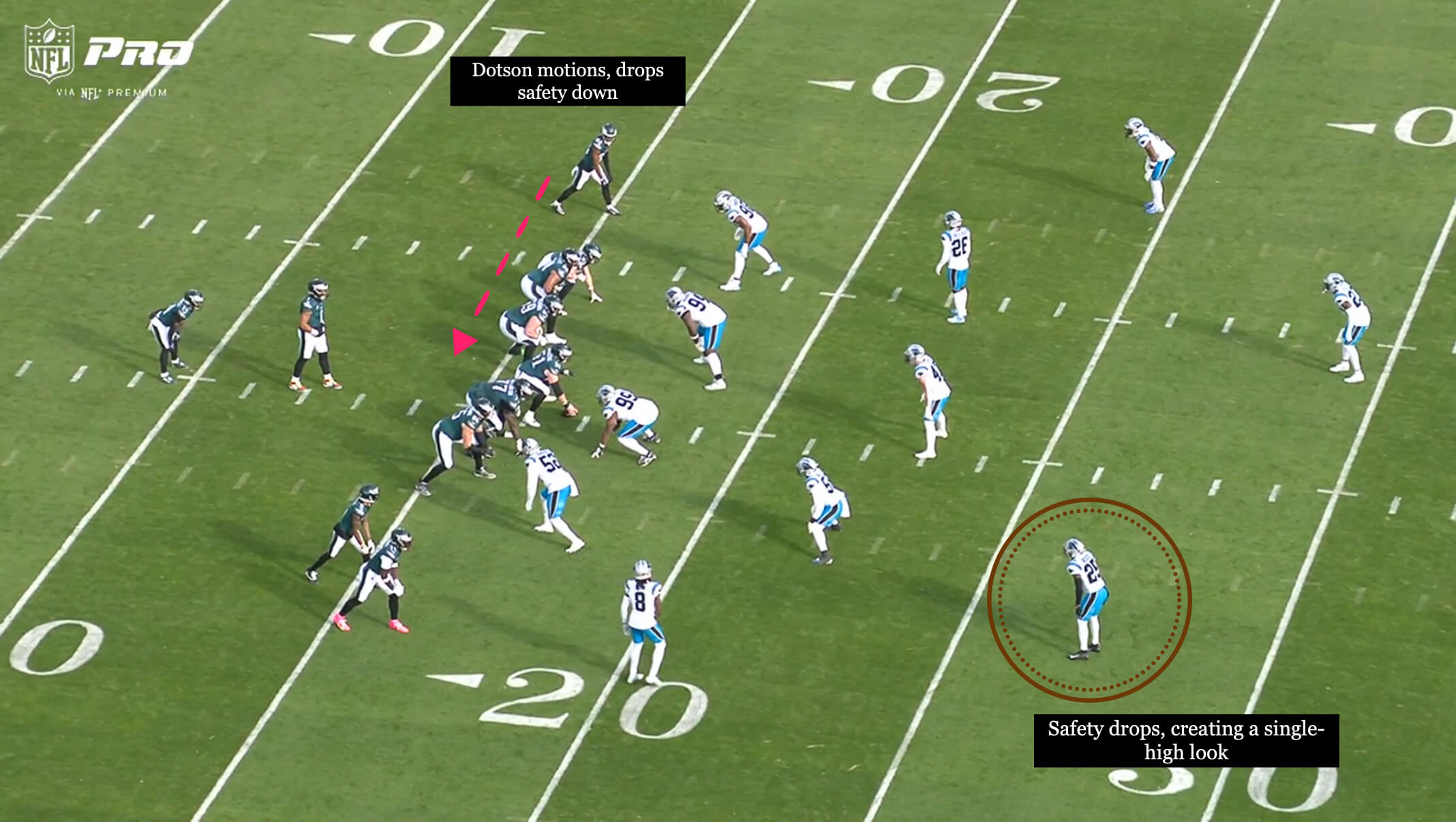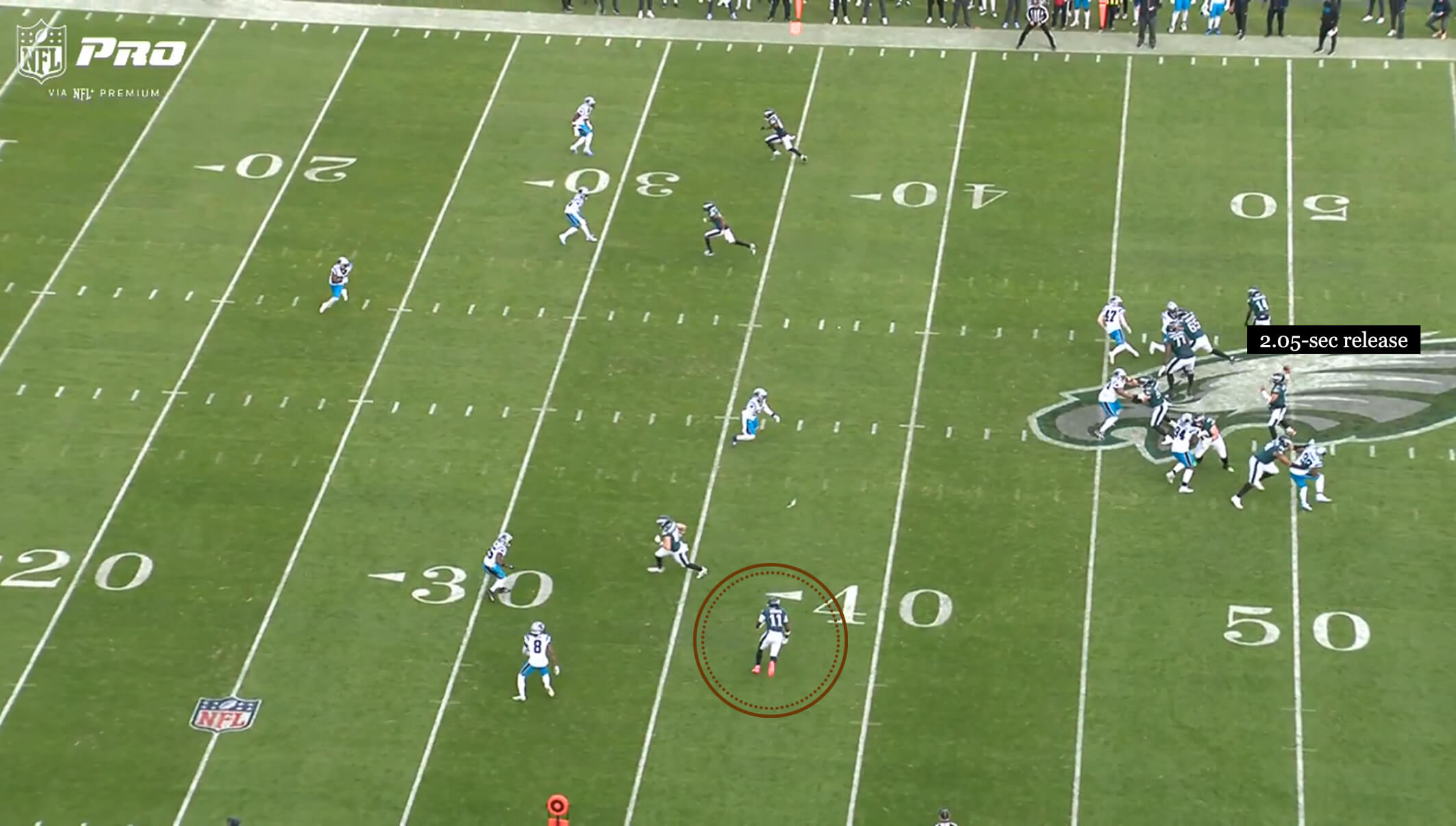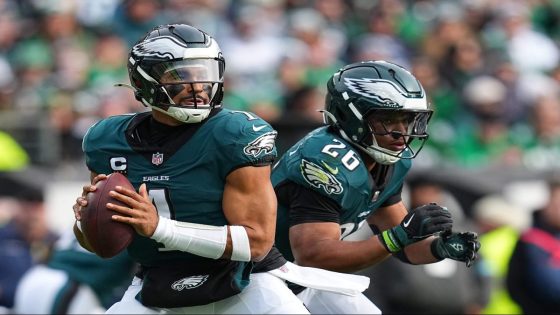Beneath needless drama, there lies an actual issue. The Philadelphia Eagles are refining critical problems within their passing game. It is a football issue. And since it involves a cryptic franchise quarterback and a three-time Pro Bowl receiver who becomes terse when he’s tense, there’s enough undeveloped real estate where there should be clarity to invite a few forest fires.
Brandon Graham lit his own match. The injured edge rusher stoked the flames beneath Jalen Hurts and A.J. Brown, his fellow team captains, by saying on his weekly radio show Monday on WIP-FM that Hurts and Brown were friends “but things have changed.” After his comment triggered a social media maelstrom, Graham gave an on-air apology Tuesday morning, saying he made an “assumption” about the duo’s relationship based on Brown’s postgame interview after Sunday’s narrow win over the Carolina Panthers.
Asked what needed to improve offensively, Brown had said: “Passing.” Brown is known to be careful with his words when managing his immediate emotions. For a few weeks during the 2023 late-season collapse, Brown avoided media appearances entirely. Brown later apologized to his teammates during a team meeting for that decision, since it placed them in a situation in which they had to cover for him. He also spent 13 minutes at his locker dispelling myths with reporters about his relationship with Hurts and coach Nick Sirianni.
Sirianni, during his own radio appearance, spent part of his Tuesday morning denouncing this year’s drama as “speculation” — something Graham admitted he was guilty of himself. At last, after hanging up the phone, Sirianni and his coaching staff could return to identifying solutions to the passing game’s actual problems.
There’ll undoubtedly be some form of similar say from the quarterback and his top target this week. But Sirianni, Hurts and Brown have before said their public displays of frustration are rooted in such on-field problems. Solve those, win, and there’s harmony. It couldn’t have helped that it was the rebuilding Panthers who further exposed the weaknesses that could prevent the Eagles from winning their second Super Bowl.
No one within the NovaCare Complex is denying that the passing game is a problem. It is the most alarming thing about this playoff-bound team. It is well-documented that the Eagles offense rightfully runs through Saquon Barkley. Sirianni and offensive coordinator Kellen Moore have constructed a system in which Hurts complements Barkley in the zone-read game and exploits favorable one-on-one matchups in the passing game. It is an unsaid inference that if Hurts fulfills his reduced role without turning the ball over, the Eagles can ride Barkley to victory. The Eagles have won nine straight games with Hurts in this role. But even Hurts acknowledged Sunday that he must “go out and execute” in the passing game and deliver “a more complementary style of ball.”
Philadelphia has often thumped its opponents due to its defense’s and Barkley’s dominance. On Sunday, it was the passing game’s turn to put the Panthers away. Instead, it faltered in critical moments, handed the ball back to an opponent who churned out an advantage on time of possession and let the significantly less-talented Panthers hang around until Xavier Legette dropped what would’ve been a final and fatal blow. The incoming Pittsburgh Steelers rank first in time of possession margin. The NFC-leading Detroit Lions rank second. It’s not difficult to imagine either team succeeding with Carolina’s game plan.
A disjointed passing game kept the Eagles from sustaining drives. They trailed the Panthers 10-7 late in the first half when Hurts overthrew Johnny Wilson on one of Philadelphia’s two three-and-outs. Brown, who’d yet to be targeted, threw his helmet onto the bench. If C.J. Gardner-Johnson hadn’t picked off Bryce Young on the subsequent defensive possession, the Eagles might’ve trailed at halftime — or worse. The turnover prompted an up-tempo touchdown drive with 1:50 left in the half in which Hurts was 5-of-5 passing for 28 yards (twice targeting Brown for 17 yards), scrambled for 15 yards and struck DeVonta Smith for a 4-yard score.
Moore referenced that two-minute drive when he said Tuesday that there was “some situational football I think we did really well.” Indeed, Hurts has a second-ranked 0.53 EPA per attempt during two-minute drives, according to TruMedia. Young also delivered the Eagles an extra possession Hurts never returned. Hurts has turned the ball over once during their nine-game win streak. Moore lauded the quarterback’s preservation as “an incredible job” within the passing game’s “first and foremost” factor. But there’s a clear trend that suggests at least some of that ball security is due to Hurts’ recent reluctance to throw the ball downfield.
Hurts has attempted two passes of 20-plus air yards in his last four games, per TruMedia. That’s the fewest of 30 quarterbacks who’ve thrown at least 50 passes in that span. It’s a significant reduction for Hurts, even within an Eagles offense that’s averaging its fewest pass attempts per game (25.2) since 1978 (25.06). Hurts attempted 31 passes of 20-plus air yards from Weeks 1-10, which were tied for 15th most among quarterbacks.
Against the Panthers, Hurts settled for a first-and-18 checkdown to Jahan Dotson on his first dropback of the game when it appeared Brown was open deep. Neither Sirianni nor Moore would address the play specifically. But it involved several elements of what usually generates explosive passes within their system. Dotson’s motion into a trips alignment prompted safety Xavier Woods to drop down in what became a favorable single-high defensive structure. Woods covered Dotson in the flats. Cornerback Jaycee Horn dropped in a deeper zone before picking up Smith on a mid-level out. That left Brown alone against safety Jordan Fuller with the greenery between the numbers and the sideline cleared for a deep strike. Hurts, with ample pass protection, chose Dotson.



When asked about the downward trend of deep shot attempts, Sirianni and Moore offered very little insight into their own interpretations — even in generic terms. Sirianni only said, “Jalen tries to go to the right place with the football based off the defense we’re getting and the way we’re trying to attack.” Moore said deeper throws are “something we’d love to give ourselves more opportunities” to secure, but “you’ve got to balance out what you love to do and what you need to do to perform and win games, ultimately.” Based on their answers — the way we’re trying to attack, what you need to do to win games — the inference is simply that they decided Hurts taking those deep shots is neither the way they wanted to attack nor what they thought they needed to do to win.
That strategy wouldn’t be without substance. During Philadelphia’s 2-2 start, Hurts threw four interceptions and lost three fumbles while often searching for longer completions. On passes of 20-plus air yards in those first four weeks, Hurts was 2 of 12 for 110 yards, a touchdown and two interceptions — a -0.06 EPA per attempt that ranked 22nd among quarterbacks in that span. Hurts was intercepted in the Sao Paulo season opener while heaving a pass off his back foot from his own end zone, trying to hit Smith amidst triple coverage in the middle of the field. Hurts was also intercepted on a deep attempt to Smith along the left sideline against the Atlanta Falcons in Week 2.
Hurts has only thrown one interception since workshopping the offense with Sirianni and Moore during their Week 5 bye. Their tweaks didn’t initially require Hurts to abandon the deep ball. Hurts was at first more efficient with attempts of 20-plus air yards. From Weeks 6-10, he was 10 of 19 for 346 yards and five touchdowns. His 1.29 EPA per attempt on such passes ranked second among quarterbacks. But the five teams in that span — the Browns, Giants, Bengals, Jaguars and Cowboys — have a combined .277 win percentage and are among the NFL’s worst in terms of defensive EPA per dropback.
At the very least, that indicates Hurts can deliver the deep ball against defenses the Eagles coaching staff deems vulnerable. No team surrenders more completions of 20-plus air yards than the Cleveland Browns (27). Hurts completed a 22-yard touchdown pass to Brown in their Week 6 win, in which Hurts also put the game away with a 40-yard pass to Brown in man coverage. The New York Giants have the league’s worst defensive EPA per dropback against passes of 20-plus air yards (-1.07). Hurts struck Brown in a clear one-on-one coverage with cornerback Nick McCloud on a 41-yard touchdown along the left sideline in their 28-3 win.
The Eagles seemed to deliberately attack their opponents deep during that span. Smith and Brown played off one another during Smith’s 45-yard touchdown reception against the Cincinnati Bengals. Brown was passed off along the right sideline in zone coverage. Smith weaved inside, dodging safety Geno Stone, who covered Brown, and was chased late by safety Jordan Battle. Hurts launched a pass that traveled 45 yards in the air — his longest attempt in 2024, per Tru Media — and struck Smith in stride in the end zone.



There’s little questioning whether Hurts has the arm strength to make such throws. After a 28-23 win over the Jacksonville Jaguars, Hurts rebuffed a reporter’s suggestion that he had a knack for the deep ball as “funny” because “you,” in general terms, said “I can’t.” It’s uncertain who Hurts was referring to, since his arm strength was considered a plus even during his draft process. Hurts hit Smith on a 46-yard dagger that put the Jaguars away during a decisive fourth-quarter drive. The Jaguars are the NFL’s second-worst team against attempts of 20-plus air yards in terms of EPA (-0.97).
If the lack of downfield throws is a concerted trade-off for the short game, that strategy hasn’t been efficient in the last four games. Hurts ranks 18th in EPA per attempt (0.15) in that span, and he’s been sacked nine times despite having the second-most average time in the pocket to throw (3.36 seconds), according to TruMedia.
The data suggests Hurts hasn’t been decisive. The film does, too. Against the Panthers, on a third-and-18 situation, Hurts took 3.8 seconds to throw a hitch to Dotson. A split-second earlier, and cornerback Mike Jackson might not have had enough time to close and bat the pass incomplete. In a similar situation during Philadelphia’s final drive, Smith ran a second-and-13 hitch against Jackson. Hurts was late (3.03 secs to throw, per TruMedia) and Jackson batted the pass incomplete.
Hurts appeared to frequently take the tougher of an array of passing options. On second-and-7 late in the second quarter, he didn’t throw to Brown, who was open on an inside cut. Instead, Hurts scrambled and threw the ball away. On the following play, Brown had one-on-one coverage with Horn along the right sideline. Hurts instead settled for Wilson, but the pass sailed incomplete. On second-and-goal at the Carolina 4, Dotson’s pick freed Brown on an inward slant, but Hurts chose to throw to a tightly covered Smith. The throw still resulted in a 4-yard touchdown. But it was a needlessly tougher throw.

Again, in the fourth quarter, trailing 16-13 on third-and-goal at the 4, Hurts took the harder of two throws. Brown was open on the slant to the left. Tight end Grant Calcaterra had yet to break inside. Hurts waited out Calcaterra and dished him the 4-yard touchdown, the tight end’s first score of his career.

That Hurts didn’t seem to see Brown was particularly curious. Sirianni has often argued Brown is the best receiver in Eagles history. He’s fielded 1,400-yard seasons in each of his previous two years with Hurts. He ranks fourth in the NFL with 17.4 yards per reception. Brown totaled four catches for 43 yards against the Panthers. But his first target didn’t arrive until the two-minute drill to finish the first half, when the Panthers played soft coverage against him. Hurts was decisive on both throws, each delivered within 2.1 seconds.




Moore insisted Hurts and the Eagles offense has “done a really, really good job” if “you look at this from a wider lens.” Moore underlined the mobility of Hurts, who ranks third among quarterbacks with 544 rushing yards. Indeed, 93 of Philadelphia’s 209 rushing yards originated from the zone-read option game. Hurts also escaped pressure, trailing 16-14 with 29 seconds left in the third quarter, when he tucked and ran on a third-and-10 play in which he gained 35 yards to the Carolina 9. Hurts completed the go-ahead touchdown to Calcaterra three plays later.
“I don’t think the offense in general, as far as our pass game, was to our standard,” Sirianni said. “But make no mistake about it: We’ve won nine games in a row, and Jalen Hurts is a big reason why we’ve won nine games in a row.”
(Top photo: Mitchell Leff / Getty Images)





